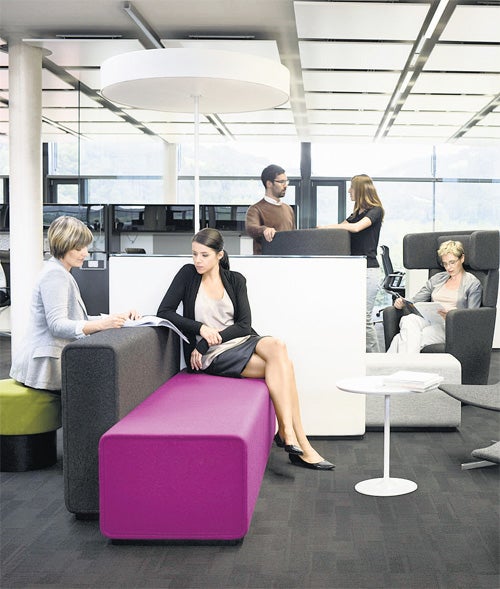The shape of things to sit on
Office buildings are no longer the regimented spaces they once were – and modern furniture is increasingly reflecting this new reality

Your support helps us to tell the story
From reproductive rights to climate change to Big Tech, The Independent is on the ground when the story is developing. Whether it's investigating the financials of Elon Musk's pro-Trump PAC or producing our latest documentary, 'The A Word', which shines a light on the American women fighting for reproductive rights, we know how important it is to parse out the facts from the messaging.
At such a critical moment in US history, we need reporters on the ground. Your donation allows us to keep sending journalists to speak to both sides of the story.
The Independent is trusted by Americans across the entire political spectrum. And unlike many other quality news outlets, we choose not to lock Americans out of our reporting and analysis with paywalls. We believe quality journalism should be available to everyone, paid for by those who can afford it.
Your support makes all the difference.Not so long ago, office buildings were pretty straightforward places. There were large open spaces, filled with rows of desks and chairs, where the junior staff worked in clear view of their superiors, who had cubicles – of varying degrees of comfort – around the edge. This was the office life of The Apartment and Reggie Perrin.
Then came computers and the recessions of the 1980s and the 1990s. The former enabled businesses to do away with many of the typists and other administrative staff that took up those large spaces, while the recessions, particularly the later one, forced companies to cut costs so deeply that they began to question the need for those traditional headquarters buildings. Helped by the explosion in computing power and the rapid development of the personal computer, businesses began to look at encouraging their staff to use their space more flexibly, through sharing desks and using communal meeting rooms rather than dedicated offices.
The rise in mobile communications has just accelerated that trend. The result is that office buildings – particularly those of telecommunications companies such as O2 or BT – increasingly look more like airport terminals than the offices our parents would recall. Even the charity Oxfam has an open-plan headquarters building where managers are as likely to be chatting over coffees in the staff canteen as working away in offices.
Attractive as this may be for a new generation of workers who are as comfortable working on a laptop in a coffee shop as making a slide presentation in a seminar room, it is not an especially welcome development if you are a maker of traditional office furniture. Which is why Bene, an Austrian-based €250m turnover company with operations around the world, took, for it, the unusual step of collaborating with an outside design agency to produce furniture more fitting for
the new ways of working. The designers commissioned – the London-based PearsonLloyd – have helped it to come up with a system of modular furniture they believe overcomes the limitations of old-style office furniture for the new type of working.
Bene is, of course, not the first to address this need. The comfortable chairs in garish colours in reception areas around the world are testament |to the new approach. But the company does believe it is pioneering in taking a holistic approach in keeping with its ethos that its product is “the workspace solution”.
The Parcs range of what the company terms “new meeting environments” features pieces ranging from an American diner-style banquet for casual meetings, through an enclosed seating area inspired by African huts and designed for meetings where privacy and close proximity are required, |to more conventional sofa arrangements. All are designed to work on their own or in tandem with any of the others to create “spaces that facilitate different types of activities without defining precisely how people are going to use them”.
Nor is it just the shape that is different. The colours range from the bright to the garish. How many companies will go for the more extreme end of the palette is open to question, but those that adopt this sort of furniture will perhaps demonstrate that some businesses really do recognise that, in the words of Luke Pearson and Tom Lloyd, you can create as much value sitting on a sofa |as at a desk.
Join our commenting forum
Join thought-provoking conversations, follow other Independent readers and see their replies
Comments